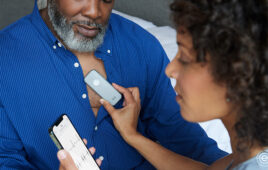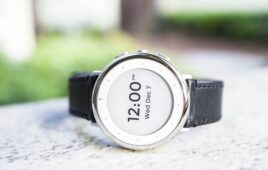With a sensor-based onesie that tracks a baby’s health, MIT spinout Rest Devices is bringing innovation to baby monitoring.
One of today’s rising tech trends, wearable technology — such as fitness-tracking bracelets, smartwatches, and smartglasses — figured prominently at this January’s Consumer Electronics Show, held in Las Vegas.
Among the wearable technology that caught some media attention was a so-called “smart baby monitor” — an innovative, sensor-implanted onesie being commercialized by a team of MIT alumni through their startup, Rest Devices.
Photos of the Day: A Monitoring Baby Onesie
Dubbed the Mimo kimono, the baby monitor, based on the co-founders’ MIT class projects, is a cotton, infant-sized onesie with integrated sensors that monitor a baby’s breathing and other biometrics, and relay that data to parents or caretakers in real time.
Sensors are embedded on two green fabric stripes (resembling a vine with leaves) that run diagonally up the onesie and track respiration. Attached at the end of the “vines” is a mount for a plastic module (resembling a turtle) that captures respiration data, as well as sleeping position, activity level, and body temperature.
Through a low-energy Bluetooth connection, the “turtle” relays the data in real time to a Web and mobile app via a wireless transmitter resembling a lily pad, which is also the charging station for the turtle and includes a microphone for relaying audio. Through the app, parents may tailor alerts for changes — such as in sleep position and temperature — and analyze their baby’s sleeping patterns over time.
The idea is that providing real-time updates on a sleeping infant can help alleviate a parent’s anxiety “and, in turn, help them get more — and better — sleep,” says Rest Devices co-founder Carson Darling ’11, who co-invented the Mimo technology and now leads the startup’s electronic and Web development.
“The aim is to provide peace of mind,” he says. “Parents have a lot to worry about, and anything we can do to help mitigate that concern is the target.”
The other co-founders and co-inventors include Thomas Lipoma ’11, who leads research and development at Rest Devices, and CEO Dulcie Madden, a student who is currently on leave from the MIT Sloan School of Management.
This month, Rest Devices shipped out its first, sold-out order of hundreds of Mimo kimono kits.
Rapid Prototyping and Refining
With Mimo, Rest Devices is positioned as an early innovator, along with a few other companies, in a fledgling landscape of smart baby monitors — what Madden has called “Nursery 2.0.”
But setting Rest Devices apart in the wearable-technology landscape are its sensors and algorithms, constantly tweaked over the past few years, which can detect with greater accuracy changes in respiration and movement, Darling says.
For instance, the algorithms powering the sensors embedded in the “vine” can catch minute chest expansions when a child inhales and exhales, pauses in breathing, or falls asleep, while taking into account changes over time.
“With greater accuracy, we avoid causing extra worry with false alarms,” Darling says.
This happened through years of trial and error, Darling says, “by testing it with children, seeing the data, seeing where the trends were, where we had errors, and refining it from there.”
Darling — a mechanical engineering graduate who splits the company’s “tinkering” duties with Lipoma — says this form of rapid, consistent modifying has contributed to the startup’s early success. To expedite its current testing processes, in fact, the startup recently brought in various pieces of equipment to its downtown Boston headquarters.
A desktop injection molder, for instance, allows the team to model its turtle sensors for quick testing with the product and with parents. All parts are manufactured within 100 miles of Boston, Darling says, which allows for quick product turnaround.
“Being able to have an idea, build it, and test it in a very short time frame has been valuable,” Darling says.
Inspiration in Respiration
Indeed, Rest Devices has ascended rapidly from its conceptual origins in fall 2010, when Darling and Lipoma were classmates in 6.933 (The Founder’s Journey), taught by Ken Zolot, a senior lecturer in MIT’s Department of Electrical Engineering and Computer Science. (Zolot later introduced the two students to Madden.)
This class teams students to develop and refine startup ideas through various class projects, with mentorship from MIT professors and guest entrepreneurs. The two co-founders teamed up and created a business plan for clothing that uses sensors to track a person’s breathing and other health statistics.
“Early on, we knew we wanted to start a company and this helped us find out if this device would be feasible to market,” Darling says. (Once a semester, the Rest Devices co-founders return to the class to share their story.)
Upon reassembling the next semester for 2.75 (Precision Machine Design), taught by Alexander Slocum, the Neil and Jane Pappalardo Professor of Mechanical Engineering, the trio (now including Madden) began prototyping.
This class brings in physicians to pitch problems in the medical field; student teams then attempt to engineer solutions. One guest speaker, Matt Bianchi, who runs the sleep lab at Massachusetts General Hospital, offered an idea to diagnose sleep apnea at home, instead of in sleep labs.
“There was a need for something that was easier and simpler, which spurred a lot of the work we did with measuring sleep and respiration,” Darling says.
Inspired, the team took its wearable sensor concept and formed Rest Devices as a means of measuring respiration for sleep apnea diagnosis. A rather clunky first version of the technology followed: Conductive thread was sewn into a shirt’s fabric, and sensors that resembled “metallic chunks” were attached to the chest.
“It functioned amazingly, but wasn’t very practical,” Darling says.
Baby Steps
A year of refining led to a sleeker design, with more robust and reliable sensors, along with sophisticated algorithms for monitoring breathing. Increasingly, however, during the company’s market research in early 2012, parents began asking for the technology for their babies.
“Almost every parent we talked to had the same motion of checking on their child, by going in and putting a hand on their chest or under their nose to see if they were breathing,” Darling explains. “We saw that there was an unmet need.”
They also saw that their technology, which was integrated into comfortable clothing, would work for new parents.
“Everyone puts a shirt on everyday, and it’s the same in the baby space: Almost every child is in a onesie every day. It’s something the parents are really used to and already in their routine,” Darling says. “Once we saw it wasn’t a device you had to add to your routine, we saw it was marketable.”
The company has been focused solely on the “baby space” since, with plans to develop more technology to fill out its “Nursery 2.0” product line.
Despite its medical-device roots, the Mimo is not designed to prevent, diagnose, or gather data on childhood ailments and conditions such as Sudden Infant Death Syndrome (SIDS), Darling cautions. That said, he adds, there is possibility for that down the road: “We know SIDS, for instance, is a big worry for parents,” Darling says. “In the future a medical device is something we’re interested in, but not quite yet.”




